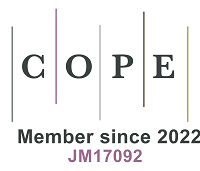REFERENCES
1. Tesi GO, Iniaghe PO. Polychlorinated biphenyls in canned sardines in Nigeria and health risk assessment. Food Addit Contam Part B Surveill 2020;13:200-6.
2. Visha A, Gandhi N, Bhavsar SP, Arhonditsis GB. A Bayesian assessment of polychlorinated biphenyl contamination of fish communities in the Laurentian Great Lakes. Chemosphere 2018;210:1193-206.
3. Irerhievwie GO, Iwegbue CMA, Lari B, Tesi GO, Nwajei GE, Martincigh BS. Spatial characteristics, sources, and ecological and human health risks of polychlorinated biphenyls in sediments from some river systems in the Niger Delta, Nigeria. Mar Pollut Bull 2020;160:111605.
4. Iwegbue CMA, Bebenimibo E, Tesi GO, Egobueze FE, Martincigh BS. Spatial characteristics and risk assessment of polychlorinated biphenyls in surficial sediments around crude oil production facilities in the Escravos River Basin, Niger Delta, Nigeria. Mar Pollut Bull 2020;159:111462.
5. Tomasallo C, Anderson H, Haughwout M, Imm P, Knobeloch L. Mortality among frequent consumers of Great Lakes sport fish. Environ Res 2010;110:62-9.
6. Wang X, Xu H, Zhou Y, Wu C, Kanchanopas-Barnette P. Spatial distribution and sources of polychlorinated biphenyls in surface sediments from the Zhoushan Archipelago and Xiangshan Harbor, East China Sea. Mar Pollut Bull 2016;105:385-92.
7. Sahu SK, Ajmal PY, Pandit GG, Puranik VD. Vertical distribution of polychlorinated biphenyl congeners in sediment core from Thane Creek area of Mumbai, India. J Hazard Mater 2009;164:1573-9.
8. Apell JN, Gschwend PM. In situ passive sampling of sediments in the Lower Duwamish Waterway Superfund site: Replicability, comparison with ex situ measurements, and use of data. Environ Pollut 2016;218:95-101.
9. Zhou S, Yang H, Zhang A, Li YF, Liu W. Distribution of organochlorine pesticides in sediments from Yangtze River Estuary and the adjacent East China Sea: implication of transport, sources and trends. Chemosphere 2014;114:26-34.
10. Zhou R, Zhu L, Yang K, Chen Y. Distribution of organochlorine pesticides in surface water and sediments from Qiantang River, East China. J Hazard Mater 2006;137:68-75.
11. Van den Berg M, Birnbaum LS, Denison M, et al. The 2005 World Health Organization reevaluation of human and Mammalian toxic equivalency factors for dioxins and dioxin-like compounds. Toxicol Sci 2006;93:223-41.
12. USEPA (United States Environmental Protection Agency). Risk assessment guidance for superfund, volume 1: human health evaluation manual (Part A). Available from: https://www.epa.gov/sites/default/files/2015-09/documents/rags_a.pdf [Last accessed on 5 Sep 2022].
13. USEPA (United States Environmental Protection Agency). Risk assessment guidance for superfund (RAGS): part F. Available from: https://www.epa.gov/risk/risk-assessment-guidance-superfund-rags-part-f [Last accessed on 5 Sep 2022].
14. USEPA (United States Environmental Protection Agency). Regional screening levels (RSL) - generic tables. Available from: http://www.epa.gov/risk/risk-based-screening-table-generic-tables [Last accessed on 5 Sep 2022].
15. Barhoumi B, LeMenach K, Dévier MH, et al. Distribution and ecological risk of polychlorinated biphenyls (PCBs) and organochlorine pesticides (OCPs) in surface sediments from the Bizerte lagoon, Tunisia. Environ Sci Pollut Res Int 2014;21:6290-302.
16. Habibullah-Al-Mamun M, Kawser Ahmed M, Saiful Islam M, Tokumura M, Masunaga S. Occurrence, distribution and possible sources of polychlorinated biphenyls (PCBs) in the surface water from the Bay of Bengal coast of Bangladesh. Ecotoxicol Environ Saf 2019;167:450-8.
17. Zhang L, Shi S, Dong L, Zhang T, Zhou L, Huang Y. Concentrations and possible sources of polychlorinated biphenyls in the surface water of the Yangtze River Delta, China. Chemosphere 2011;85:399-405.
18. Cui X, Dong J, Huang Z, et al. Polychlorinated biphenyls in the drinking water source of the Yangtze River: characteristics and risk assessment. Environ Sci Eur 2020:32.
19. Unyimadu JP, Osibanjo O, Babayemi JO. Polychlorinated biphenyls (PCBs) in River Niger, Nigeria: Occurrence, distribution and composition profiles. Toxicol Ind Health 2018;34:54-67.
20. Ezemonye LIN. Polychlorinated biphenyls (PCBs) levels and distribution in Ethiope and Benin Rivers of the Niger Delta, Nigeria: surface water and sediments. Int J Envir Studies 2005;62:491-504.
21. Megahed AM, Dahshan H, Abd-El-Kader MA, et al. Polychlorinated biphenyls water pollution along the River Nile, Egypt. Sci World J :2015.
22. Yang Y, Xie Q, Liu X, Wang J. Occurrence, distribution and risk assessment of polychlorinated biphenyls and polybrominated diphenyl ethers in nine water sources. Ecotoxicol Environ Saf 2015;115:55-61.
23. Amdany R, Chimuka L, Cukrowska E, et al. Assessment of bioavailable fraction of POPS in surface water bodies in Johannesburg City, South Africa, using passive samplers: an initial assessment. Environ Monit Assess 2014;186:5639-53.
24. Adeogun AO, Chukwuka AV, Okoli CP, Arukwe A. Concentration of polychlorinated biphenyl (PCB) congeners in the muscle of Clarias gariepinus and sediment from inland rivers of southwestern Nigeria and estimated potential human health consequences. J Toxicol Environ Health A 2016;79:969-83.
25. Ilechukwu I, Mgbemena NM, Inagbor PO, Ndukwe GI. Assessment of the levels of polychlorinated biphenyls in sediments of new Calabar River, Niger Delta Region, Nigeria. Ovidius Univ Ann Chem 2018;29:36-40.
26. Iwegbue C. Distribution and ecological risks of polychlorinated biphenyls (PCBs) in surface sediment of the Forcados River, Niger Delta, Nigeria. Afric J Aquat Sci 2016;41:51-6.
27. Sahavacharin A. Spatial and temporal landscape change of Andaman coastal city and forest, Thailand. J Coast Zone Manag 2017:20.
28. Gakuba E, Moodley B, Ndungu P, Birungi G. Occurrence and significance of polychlorinated biphenyls in water, sediment pore water and surface sediments of Umgeni River, KwaZulu-Natal, South Africa. Environ Monit Assess 2015;187:568.
29. Hellar-Kihampa H, De Wael K, Lugwisha E, Malarvannan G, Covaci A, Van Grieken R. Spatial monitoring of organohalogen compounds in surface water and sediments of a rural-urban river basin in Tanzania. Sci Total Environ 2013;447:186-97.
30. Barakat AO, Khairy M, Aukaily I. Persistent organochlorine pesticide and PCB residues in surface sediments of Lake Qarun, a protected area of Egypt. Chemosphere 2013;90:2467-76.
31. Nouira T, Risso C, Chouba L, Budzinski H, Boussetta H. Polychlorinated biphenyls (PCBs) and Polybrominated Diphenyl Ethers (PBDEs) in surface sediments from Monastir Bay (Tunisia, Central Mediterranean): occurrence, distribution and seasonal variations. Chemosphere 2013;93:487-93.
32. Verhaert V, Covaci A, Bouillon S, et al. Baseline levels and trophic transfer of persistent organic pollutants in sediments and biota from the Congo River Basin (DR Congo). Environ Int 2013;59:290-302.
33. Ozyürek NA, Gedik K, Siltu E, Imamoğlu I. Levels and sources of polychlorinated biphenyls in Ankara creek sediments, Turkey. J Environ Sci Health A Tox Hazard Subst Environ Eng 2013;48:800-8.
34. Zhao L, Hou H, Zhou Y, Xue N, Li H, Li F. Distribution and ecological risk of polychlorinated biphenyls and organochlorine pesticides in surficial sediments from Haihe River and Haihe Estuary Area, China. Chemosphere 2010;78:1285-93.
35. Tolosa I, Mesa-Albernas M, Alonso-Hernandez CM. Organochlorine contamination (PCBs, DDTs, HCB, HCHs) in sediments from Cienfuegos bay, Cuba. Mar Pollut Bull 2010;60:1619-24.
36. Eqani SA, Malik RN, Zhang G, Mohammad A, Chakraborty P. Polychlorinated biphenyls (PCBs) in the sediments of the River Chenab, Pakistan. Chemi Ecol 2012;28:327-39.
37. Leung A, Cai ZW, Wong MH. Environmental contamination from electronic waste recycling at Guiyu, southeast China. J Mater Cycles Waste Manag 2006;8:21-33.
38. Martinez A, Norström K, Wang K, Hornbuckle KC. Polychlorinated biphenyls in the surficial sediment of Indiana Harbor and Ship Canal, Lake Michigan. Environ Int 2010;36:849-54.
39. Zahed MA, Nabi Bidhendi G, Pardakhti A, Esmaili-Sari A, Mohajeri S. Determination of polychlorinated biphenyl congeners in water and sediment in North West Persian Gulf, Iran. Bull Environ Contam Toxicol 2009;83:899-902.
40. Subedi B, Yun S, Jayaraman S, Bergen BJ, Kannan K. Retrospective monitoring of persistent organic pollutants, including PCBs, PBDEs, and polycyclic musks in blue mussels (Mytilus edulis) and sediments from New Bedford Harbor, Massachusetts, USA: 1991-2005. Environ Monit Assess 2014;186:5273-84.
41. VROM. Intervention values and target values: soil quality standards, Netherlands Ministry of Housing, Spatial Planning and Environment, Department of Soil Protection. The Hague, Netherlands. Available from: https://www.esdat.net/environmental%20standards/dutch/annexs_i2000dutch%20environmental%20standards.pdf [Last accessed on 5 Sep 2022].
42. ANZECC/NHMRC (Australia and New Zealand Environment and Conservation Council/National Health and Medical Research Centre). Guideline for assessment and management of contaminated soil. Available from: http://www.nepc.gov.au/system/files/resources/378b7018-8f2a-8174-3928-2056b44bf9b0/files/anzecc-gl-assessment-site-containment-contaminated-soil.pdf [Last accessed on 5 Sep 2022].
43. CCME (2007). Canadian Soil Quality Guidelines for the Protection of Environmental and Human Health. Available from: https://www.esdat.net/environmental%20standards/canada/soil/rev_soil_summary_tbl_7.0_e.pdf [Last accessed on 5 Sep 2022].
44. Rudel RA, Seryak LM, Brody JG. PCB-containing wood floor finish is a likely source of elevated PCBs in residents’ blood, household air and dust: a case study of exposure. Environ Health 2008;7:2.
45. Williams LL, Giesy JP. Relationships Among Concentrations of Individual Polychlorinated Biphenyl (PCB) Congeners, 2,3,7,8-Tetrachlorodibenzo-P-Dioxin Equivalents (TCDD-EQ), and Rearing Mortality of Chinook Salmon (Oncorhynchus Tshawytscha) Eggs from Lake Michigan. J Great Lakes Res 1992;18:108-24.
46. Giesy JP, Verbrugge DA, Othout RA, et al. Contaminants in fishes from Great Lakes-influenced sections and above dams of three Michigan rivers. I: Concentrations of organo chlorine insecticides, polychlorinated biphenyls, dioxin equivalents, and mercury. Arch Environ Contam Toxicol 1994;27:202-12.
47. Hugla JL, Thys I, Hoffman L, et al. Contamination par les PCBs et les pesticides organochlorés des poissons du Grand-Duché de Luxembourg : incidence possible surles populations de loutre (Lutra lutra L.). Annales de Limnologie - Inte J Limnol 1998;34:201-9.
48. Adeyemi D, Ukpo G, Anyakora C, et al. Polychlorinated biphenyl in fish samples from Lagos Lagoon, Nigeria. Afr J Biotechnol 2009;8:2811-2815. Available from: https://www.ajol.info/index.php/ajb/article/view/60880 [Last accessed on 6 Sep 2022]
49. Oziolor EM, Apell JN, Winfield ZC, Back JA, Usenko S, Matson CW. Polychlorinated biphenyl (PCB) contamination in Galveston Bay, Texas: Comparing concentrations and profiles in sediments, passive samplers, and fish. Environ Pollut 2018;236:609-18.
50. Cocco E, Guignard C, Hoffmann L, Bohn T. Rapid analysis of polychlorinated biphenyls in fish by pressurised liquid extraction with in-cell cleanup and GC-MS. Int J Envir Analyt Chem 2011;91:333-47.
51. Voorspoels S, Covaci A, Maervoet J, De Meester I, Schepens P. Levels and profiles of PCBs and OCPs in marine benthic species from the Belgian North Sea and the Western Scheldt Estuary. Mar Pollut Bull 2004;49:393-404.
52. Jiang QT, Lee TK, Chen K, et al. Human health risk assessment of organochlorines associated with fish consumption in a coastal city in China. Environ Pollut 2005;136:155-65.
53. Uekusa Y, Takatsuki S, Tsutsumi T, et al. Determination of polychlorinated biphenyls in marine fish obtained from tsunami-stricken areas of Japan. PLoS One 2017;12:e0174961.
54. Jafarabadi A, Riyahi Bakhtiari A, Mitra S, Maisano M, Cappello T, Jadot C. First polychlorinated biphenyls (PCBs) monitoring in seawater, surface sediments and marine fish communities of the Persian Gulf: Distribution, levels, congener profile and health risk assessment. Environ Pollut 2019;253:78-88.







